From tales of mythical beasts, to historical fantasies, epic quests, and intergalactic thrillers, the recently published, playful, and inventive books in this week’s column take readers to fantastical worlds and invite the delight of imaginative possibilities.
Ages 4–8
The Giant of Jum. Elli Woollard. Ill. Benji Davies. 2017. Henry Holt.
 The grumpy Giant of Jum, with his rumbling tummy, thinks Jack, with a side of dish of beans, would be the perfect snack. Setting out in search of Jack, he meets a group of children. “‘Fum!’ he said, and ‘Fo!’ he said, and ‘Fi!’ he said, and ‘Fee! / Children, I feel, make a fabulous meal. / I will gobble you up with my tea!’” His original plans for a “little Jack snack” are forgotten as the children (including Jack) declare him to be a nice giant. After he does three good deeds for them, and they reward him with a giant-sized CAKE! Clever wordplay and brightly colored illustrations make this story in rhyme a good choice for reading aloud.
The grumpy Giant of Jum, with his rumbling tummy, thinks Jack, with a side of dish of beans, would be the perfect snack. Setting out in search of Jack, he meets a group of children. “‘Fum!’ he said, and ‘Fo!’ he said, and ‘Fi!’ he said, and ‘Fee! / Children, I feel, make a fabulous meal. / I will gobble you up with my tea!’” His original plans for a “little Jack snack” are forgotten as the children (including Jack) declare him to be a nice giant. After he does three good deeds for them, and they reward him with a giant-sized CAKE! Clever wordplay and brightly colored illustrations make this story in rhyme a good choice for reading aloud.
—CA
Time Now to Dream. Timothy Knapman. Ill. Helen Oxenbury. 2017. Candlewick.
 Alice and her little brother Jack are playing ball when they decide to explore the weird sounds they hear coming from the forest. Alice wants to explore, but Jack is timid. “What if it’s the Wicked Wolf?” As they venture deep, and then deeper, into the forest, they hear more haunting fragments of a song, and Jack adds more details to his worries about the Wicked Wolf (“big bad claws” and “snap-trap jaws”) while Alice reassures him that, “Everything is going to be all right.” In an unexpected turn of events, it is Alice who wants to flee as Jack discovers the source of the sounds: a mother wolf singing a lullaby to her three cubs. Knapman’s sparse, patterned fairy tale-like text and Oxenbury’s dreamy, softly colored pencil-and-watercolor illustrations make this fantasy adventure a good read-aloud choice.
Alice and her little brother Jack are playing ball when they decide to explore the weird sounds they hear coming from the forest. Alice wants to explore, but Jack is timid. “What if it’s the Wicked Wolf?” As they venture deep, and then deeper, into the forest, they hear more haunting fragments of a song, and Jack adds more details to his worries about the Wicked Wolf (“big bad claws” and “snap-trap jaws”) while Alice reassures him that, “Everything is going to be all right.” In an unexpected turn of events, it is Alice who wants to flee as Jack discovers the source of the sounds: a mother wolf singing a lullaby to her three cubs. Knapman’s sparse, patterned fairy tale-like text and Oxenbury’s dreamy, softly colored pencil-and-watercolor illustrations make this fantasy adventure a good read-aloud choice.
—NB
A True Home (Heartwood Hotel #1). Kallie George. Ill. Stephanie Graegin. 2017. Disney Hyperion.
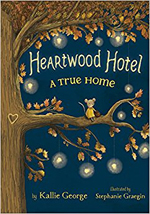 When her home is washed away by heavy rainfall, Mona, an orphaned mouse, finds shelter at the Heartwood Hotel, a grand establishment for woodland animals in Fernwood Forest. Given a bed for the night by Mr. Heartwood, the badger proprietor, in exchange for helping clean up after the evening’s Acorn Festival party, Mona does such a good job that she is asked to stay on to help Tilly, the maid, for the busy fall season. Mona becomes a favorite with both guests and staff, but as preparation for the First Snow Festival signals the start of the winter season, she realizes her time at the Heartwood will soon end. However, Mona, who is brave and clever as well as helpful and kind, saves the hotel from a pack of hungry wolves—and the hotel becomes her “true home.” Mona’s adventures at the Heartwood Hotel continue in The Greatest Gift, the simultaneously published second book in this cozy animal fantasy chapter book series.
When her home is washed away by heavy rainfall, Mona, an orphaned mouse, finds shelter at the Heartwood Hotel, a grand establishment for woodland animals in Fernwood Forest. Given a bed for the night by Mr. Heartwood, the badger proprietor, in exchange for helping clean up after the evening’s Acorn Festival party, Mona does such a good job that she is asked to stay on to help Tilly, the maid, for the busy fall season. Mona becomes a favorite with both guests and staff, but as preparation for the First Snow Festival signals the start of the winter season, she realizes her time at the Heartwood will soon end. However, Mona, who is brave and clever as well as helpful and kind, saves the hotel from a pack of hungry wolves—and the hotel becomes her “true home.” Mona’s adventures at the Heartwood Hotel continue in The Greatest Gift, the simultaneously published second book in this cozy animal fantasy chapter book series.
—CA
Ages 9–11
The Emperor’s Ostrich. Julie Berry. 2017. Roaring Brook.
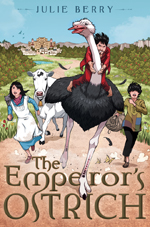 Join the adventures of milkmaid Begonia and her wandering cow, Alfalfa; Key, a farm boy and self-proclaimed Finder of Lost Things and rescuer of damsels in distress; and a rude and bedraggled stranger wearing silk pajamas (whom they call Lumi when he fails to identify himself) and his companion, an eight-foot tall ostrich. Ancestral spirits mastermind their activities as they wend their way toward Lotus City, following a magic map. Begonia, Key, and the ostrich must escape after being kidnapped by Mr. Poka, Proprietor of Poka’s Carnival of Curiosities, who wants to add the “postrich” to his menagerie. Taken to be the kidnapper of the Emperor, Lumi is captured by soldiers. All end up in the palace dungeon under orders of three nobles scheming to take over the kingdom. Silly details such as the love-struck relationship of Alfalfa and the ostrich make this a madcap, magical romp that does have a happy ending.
Join the adventures of milkmaid Begonia and her wandering cow, Alfalfa; Key, a farm boy and self-proclaimed Finder of Lost Things and rescuer of damsels in distress; and a rude and bedraggled stranger wearing silk pajamas (whom they call Lumi when he fails to identify himself) and his companion, an eight-foot tall ostrich. Ancestral spirits mastermind their activities as they wend their way toward Lotus City, following a magic map. Begonia, Key, and the ostrich must escape after being kidnapped by Mr. Poka, Proprietor of Poka’s Carnival of Curiosities, who wants to add the “postrich” to his menagerie. Taken to be the kidnapper of the Emperor, Lumi is captured by soldiers. All end up in the palace dungeon under orders of three nobles scheming to take over the kingdom. Silly details such as the love-struck relationship of Alfalfa and the ostrich make this a madcap, magical romp that does have a happy ending.
—CA
The Dragon with a Chocolate Heart. Stephanie Burgis. 2017. Bloomsbury.
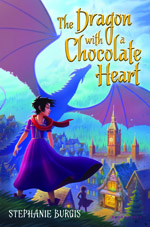 Aventurine, a young dragon, rebels against her protective family and sneaks out of their lair only to be cursed by a food mage, who transforms her into a feisty, chocolate-seeking 12-year-old human girl. Not understanding who she is as a human, but with the instincts of a dragon and lured by the scent of chocolate, she worms her way into an apprenticeship at The Chocolate Heart in the city of Drachenburg, where her experience affirms her passion for all things chocolate. When the efforts of her only human friend, Silke, to save The Chocolate Heart are sabotaged by political shenanigans and the town rallies against Aventurine’s dragon family, which has come to rescue her, she knows that she must dig deep into her “inner dragon” for a solution. It turns out that chocolate may, indeed, hold the key for a peace agreement between Drachenburg and the dragons, and that there may be a way for Aventurine to have it all: the life of a dragon, a human child, and a chocolatier!
Aventurine, a young dragon, rebels against her protective family and sneaks out of their lair only to be cursed by a food mage, who transforms her into a feisty, chocolate-seeking 12-year-old human girl. Not understanding who she is as a human, but with the instincts of a dragon and lured by the scent of chocolate, she worms her way into an apprenticeship at The Chocolate Heart in the city of Drachenburg, where her experience affirms her passion for all things chocolate. When the efforts of her only human friend, Silke, to save The Chocolate Heart are sabotaged by political shenanigans and the town rallies against Aventurine’s dragon family, which has come to rescue her, she knows that she must dig deep into her “inner dragon” for a solution. It turns out that chocolate may, indeed, hold the key for a peace agreement between Drachenburg and the dragons, and that there may be a way for Aventurine to have it all: the life of a dragon, a human child, and a chocolatier!
—NB
The Princess and the Page. Christina Farley. 2017. Scholastic.
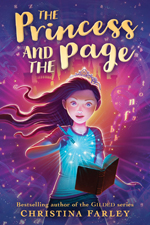 Twelve-year
Twelve-year-old Keira, forbidden by her mother to write anything creative, discovers her grandma’s magical Word Weaver pen after a robbery at her home. Angry at her mother and not knowing what the pen is (but drawn to it like a bee to honey), Keira writes a fairy tale for a writing contest. Her entry wins the prize, a trip to France for herself, her mother, and her best friend, Bella, where they will spend one week in a castle and Keira will be treated like a princess. As a series of odd and dangerous events unfolds, she sleuths the castle to find answers. Realizing that she is a Word Weaver whose fairy tale has come to life and that the princess in her story, as well as her mother, friend, and others, are in peril, Keira knows the only way she can save them is by writing a new ending and, possibly, sacrificing her own life.
—NB
Ages 12–14
Shadow Run (Kaitan Chronicles #1). AdriAnne Strickland & Michael Miller. 2017. Delacorte/Random House.
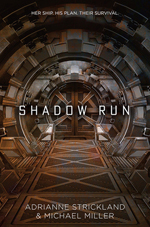 In this intergalactic thriller, Prince Nevarian Dracorte, heir to the throne of Luvos, goes undercover on the starship Kaitan Heritage to convince 17-year-old Captain Qole Uvgamut to return with him so scientists can study her special ability to control the powerful Shadow fuel upon which the universe depends. When Qole and her crew discover Nev’s covert mission, they want to pitch him off the ship, but discover they are the target of an even greater threat. Returning in the starship to his home planet, Nev presents Qole to his father (the king) but is unprepared for the court machinations, political greed, and personal betrayal that seek to destroy not only Qole, with whom he shares a growing affection, but also him. Written in alternate chapters from their points of view, this sci-fi adventure leaves Nev and Qole needing to make life-and-death decisions to survive—and readers ready for the sequel, Shadow Call (2017).
In this intergalactic thriller, Prince Nevarian Dracorte, heir to the throne of Luvos, goes undercover on the starship Kaitan Heritage to convince 17-year-old Captain Qole Uvgamut to return with him so scientists can study her special ability to control the powerful Shadow fuel upon which the universe depends. When Qole and her crew discover Nev’s covert mission, they want to pitch him off the ship, but discover they are the target of an even greater threat. Returning in the starship to his home planet, Nev presents Qole to his father (the king) but is unprepared for the court machinations, political greed, and personal betrayal that seek to destroy not only Qole, with whom he shares a growing affection, but also him. Written in alternate chapters from their points of view, this sci-fi adventure leaves Nev and Qole needing to make life-and-death decisions to survive—and readers ready for the sequel, Shadow Call (2017).
—NB
The White Road of the Moon. Rachel Neumeier. 2017. Alfred A. Knopf/Random House.
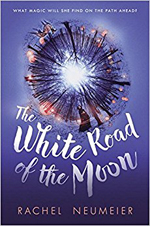 In this stand-alone epic fantasy, 15-year-old orphan Meridy, an outcast because of her witchy black eyes and dark skin, runs away from her hateful Aunt Tarana, who plans to sell her as a laundry apprentice. She begins to understand her supernatural powers when she encounters a ghost boy, ghost wolfhound, and a mysterious injured stranger. Escaping from brigands, she joins a company of merchants traveling together for safety and makes friends with Jaift, a merchant’s daughter who also has magical gifts. With the help of Jaift—and a few ghostly and human friends she gathers along the way—Meridy discovers her witch’s power to change the future through righting the wrongs of the past as she steps into the realms of dreams. Embracing her gifts and heritage, she fights evil, helps defeat the Witch King, opens the White Road into the God’s realms, and witnesses the restoration of the rightful High King to the resurrected-from-the-sea city of Moran Diorr. Transformed from a helpless orphan into a respected sorceress, Meridy is now empowered to choose her future.
In this stand-alone epic fantasy, 15-year-old orphan Meridy, an outcast because of her witchy black eyes and dark skin, runs away from her hateful Aunt Tarana, who plans to sell her as a laundry apprentice. She begins to understand her supernatural powers when she encounters a ghost boy, ghost wolfhound, and a mysterious injured stranger. Escaping from brigands, she joins a company of merchants traveling together for safety and makes friends with Jaift, a merchant’s daughter who also has magical gifts. With the help of Jaift—and a few ghostly and human friends she gathers along the way—Meridy discovers her witch’s power to change the future through righting the wrongs of the past as she steps into the realms of dreams. Embracing her gifts and heritage, she fights evil, helps defeat the Witch King, opens the White Road into the God’s realms, and witnesses the restoration of the rightful High King to the resurrected-from-the-sea city of Moran Diorr. Transformed from a helpless orphan into a respected sorceress, Meridy is now empowered to choose her future.
—NB
Ages 15+
Blood Rose Rebellion (Blood Rose Rebellion #1). Rosalyn Eves. 2017. Alfred A. Knopf/Random House.
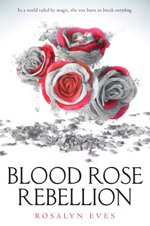 In mid-19th-century London, 16-year-old Anna Arden, whose family is part of the Luminate (the magical elite who rule society), has been labeled Barren—unable to perform spells—depleting her of rights and privileges of her class. After she inexplicably breaks her sister Catherine’s debutante spell (and possibly Catherine’s chances for a successful marriage match), Anna is exiled by her parents to live with her Grandmama in Hungary, where the country is on the cusp of war. There she meets gypsy Romani Gabor and, at her father’s request, connects with the mysterious Lady Berri. As Anna struggles with her uncontrollable chimera, two souls in one body, she must choose which side of the rebellion she is on before either the Austrian Circle (the ruling body of the Luminate) or revolutionaries successfully commandeer her power for breaking, or keeping, the Binding (Luminate rule). Back matter includes an author’s note (describing historical truths and fiction) and a glossary of Hungarian words. The sequel, Lost Crow Conspiracy, in this historical fantasy trilogy is coming soon.
In mid-19th-century London, 16-year-old Anna Arden, whose family is part of the Luminate (the magical elite who rule society), has been labeled Barren—unable to perform spells—depleting her of rights and privileges of her class. After she inexplicably breaks her sister Catherine’s debutante spell (and possibly Catherine’s chances for a successful marriage match), Anna is exiled by her parents to live with her Grandmama in Hungary, where the country is on the cusp of war. There she meets gypsy Romani Gabor and, at her father’s request, connects with the mysterious Lady Berri. As Anna struggles with her uncontrollable chimera, two souls in one body, she must choose which side of the rebellion she is on before either the Austrian Circle (the ruling body of the Luminate) or revolutionaries successfully commandeer her power for breaking, or keeping, the Binding (Luminate rule). Back matter includes an author’s note (describing historical truths and fiction) and a glossary of Hungarian words. The sequel, Lost Crow Conspiracy, in this historical fantasy trilogy is coming soon.
—NB
A Face Like Glass. Frances Hardinge. 2017. Amulet/Abrams.
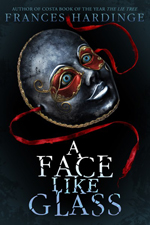 In the underground city of Caverna, babies are born with blank faces and must be taught to facially express emotions. Only the affluent can buy a full range of Faces from Facesmiths, the creators of nuanced expressions such as Face No. 312, a grave face designed to make the wearer look formidable, reliable, and respectable all at the same time. Twelve-year-old Neverfall, who has been locked away for seven years by Cheesemaster Grandible and believes she must wear a velvet mask to hide her ugly, frightening face, begins to wonder who she is and what life is like outside the cheese tunnels. When Neverfall finds a hidden passage out of the tunnels, she learns that she has “a face like glass,” a face that show all her thoughts and feelings, a face that does not let her lie. Neverfall’s face puts her in danger as she becomes a pawn of the Court and corrupt ruling families of Caverna. The plot of Hardinge’s beautifully crafted, insightful fantasy is as complicated and twisted as the tunnels of Caverna.
In the underground city of Caverna, babies are born with blank faces and must be taught to facially express emotions. Only the affluent can buy a full range of Faces from Facesmiths, the creators of nuanced expressions such as Face No. 312, a grave face designed to make the wearer look formidable, reliable, and respectable all at the same time. Twelve-year-old Neverfall, who has been locked away for seven years by Cheesemaster Grandible and believes she must wear a velvet mask to hide her ugly, frightening face, begins to wonder who she is and what life is like outside the cheese tunnels. When Neverfall finds a hidden passage out of the tunnels, she learns that she has “a face like glass,” a face that show all her thoughts and feelings, a face that does not let her lie. Neverfall’s face puts her in danger as she becomes a pawn of the Court and corrupt ruling families of Caverna. The plot of Hardinge’s beautifully crafted, insightful fantasy is as complicated and twisted as the tunnels of Caverna.
—CA
Nancy Brashear is Professor Emeritus of English from Azusa Pacific University, in Azusa, California. Carolyn Angus is former Director of the George G. Stone Center for Children's Books, Claremont Graduate University, in Claremont, California.